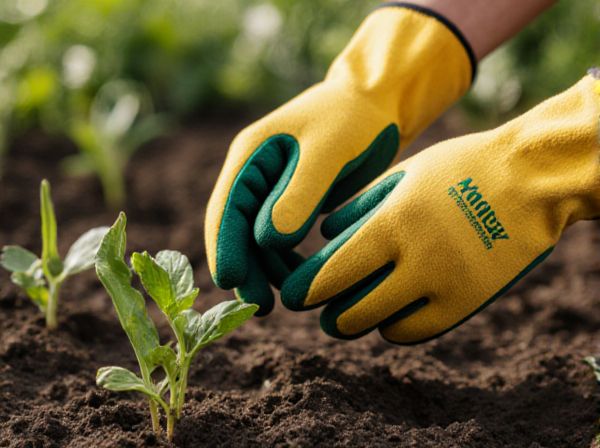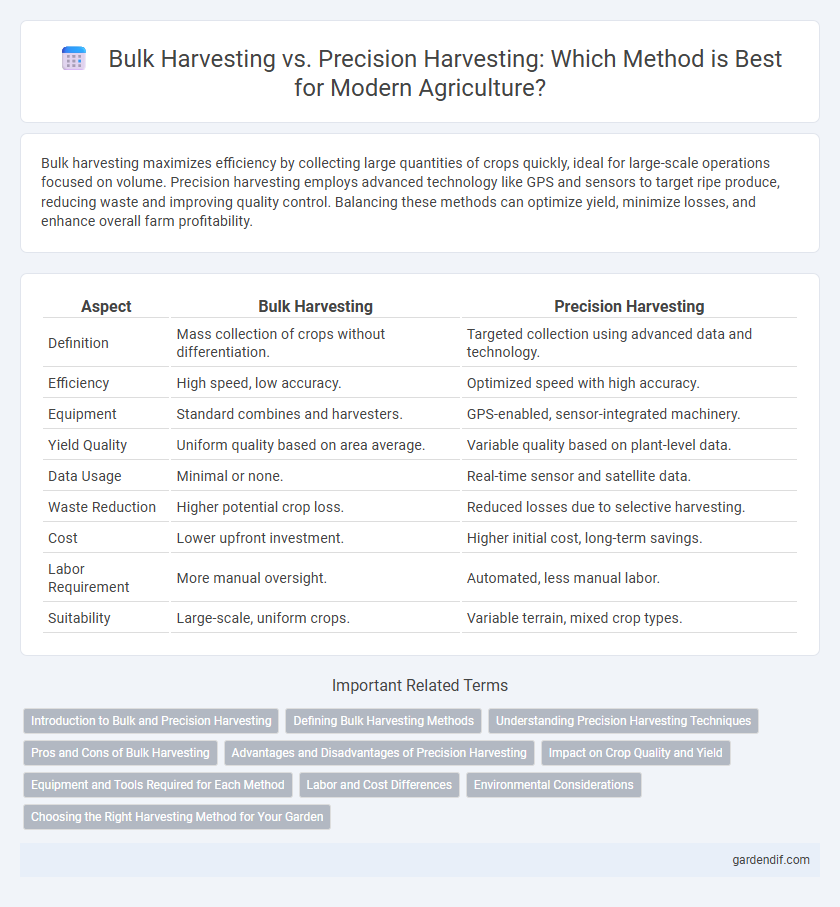
Bulk Harvesting vs Precision Harvesting Illustration
Bulk harvesting maximizes efficiency by collecting large quantities of crops quickly, ideal for large-scale operations focused on volume. Precision harvesting employs advanced technology like GPS and sensors to target ripe produce, reducing waste and improving quality control. Balancing these methods can optimize yield, minimize losses, and enhance overall farm profitability.
Table of Comparison
| Aspect | Bulk Harvesting | Precision Harvesting |
|---|---|---|
| Definition | Mass collection of crops without differentiation. | Targeted collection using advanced data and technology. |
| Efficiency | High speed, low accuracy. | Optimized speed with high accuracy. |
| Equipment | Standard combines and harvesters. | GPS-enabled, sensor-integrated machinery. |
| Yield Quality | Uniform quality based on area average. | Variable quality based on plant-level data. |
| Data Usage | Minimal or none. | Real-time sensor and satellite data. |
| Waste Reduction | Higher potential crop loss. | Reduced losses due to selective harvesting. |
| Cost | Lower upfront investment. | Higher initial cost, long-term savings. |
| Labor Requirement | More manual oversight. | Automated, less manual labor. |
| Suitability | Large-scale, uniform crops. | Variable terrain, mixed crop types. |
Introduction to Bulk and Precision Harvesting
Bulk harvesting involves collecting large quantities of crops quickly using generalized machinery designed for speed rather than selectivity, optimizing for volume over individual plant quality. Precision harvesting utilizes advanced technology such as GPS-guided equipment, sensors, and data analytics to target specific areas or plants, enhancing efficiency and reducing waste. Both methods impact yield quality, labor costs, and overall farm management strategies differently based on the scale and technological adoption of the farming operation.
Defining Bulk Harvesting Methods
Bulk harvesting methods involve collecting large quantities of crops simultaneously, typically using machinery such as combines or harvesters. This approach emphasizes rapid processing and efficiency by gathering entire fields without distinguishing between crop quality or maturity variations. Bulk harvesting minimizes labor costs but may result in mixed-quality yields and increased post-harvest sorting requirements.
Understanding Precision Harvesting Techniques
Precision harvesting techniques utilize GPS technology, sensor-equipped machinery, and real-time data analytics to optimize crop yield and reduce losses compared to traditional bulk harvesting methods. By targeting specific crop areas and adjusting harvesting parameters on-the-go, these techniques improve resource efficiency and minimize mechanical damage. Implementing precision systems enhances overall productivity while supporting sustainable agricultural practices.
Pros and Cons of Bulk Harvesting
Bulk harvesting offers the advantage of rapid crop collection, enabling farmers to manage large fields efficiently and reduce labor costs. However, this method often results in higher wastage and less precise yield data, potentially affecting overall crop quality and post-harvest processing. The lack of targeted harvesting can lead to mixed crop maturity levels, which may impact storage duration and market value.
Advantages and Disadvantages of Precision Harvesting
Precision harvesting offers significant advantages such as improved crop yield quality and reduced waste by targeting only ripe produce, enhancing overall efficiency. It utilizes advanced technologies like GPS and sensors to optimize harvest timing and labor use, lowering operational costs and environmental impact. However, high initial investment costs and the need for specialized training can limit accessibility for small-scale farmers.
Impact on Crop Quality and Yield
Bulk harvesting often leads to increased mechanical damage and mixed crop maturity levels, which can reduce overall crop quality and uniformity. Precision harvesting uses advanced sensors and GPS technology to selectively harvest crops at optimal ripeness, enhancing yield consistency and minimizing waste. This targeted approach improves both the quantity and quality of the harvest by reducing losses from overripe or underripe produce.
Equipment and Tools Required for Each Method
Bulk harvesting relies on large-scale machinery such as combine harvesters, grain carts, and swathers designed to quickly collect vast quantities of crops with minimal field passes. Precision harvesting employs advanced tools including GPS-guided harvesters, yield monitors, and sensor-equipped machinery to optimize crop collection and improve data accuracy. The integration of IoT devices and real-time analytics in precision harvesting enhances efficiency and reduces resource waste compared to traditional bulk equipment.
Labor and Cost Differences
Bulk harvesting reduces labor requirements by mechanizing large-scale crop collection, significantly lowering overall costs through decreased manual labor and faster operations. Precision harvesting demands skilled labor and advanced technology, driving higher upfront expenses but optimizing yield quality and minimizing waste. Labor-intensive precision methods justify increased costs with better resource management and improved profitability over time.
Environmental Considerations
Bulk harvesting often leads to increased soil compaction and higher crop residue loss, negatively impacting soil health and biodiversity. Precision harvesting minimizes environmental footprints by targeting specific crop areas, reducing waste and conserving water resources. Implementing precision techniques promotes sustainable farming practices and reduces greenhouse gas emissions associated with traditional bulk methods.
Choosing the Right Harvesting Method for Your Garden
Bulk harvesting maximizes efficiency by collecting large quantities of produce quickly, ideal for gardens with uniform crops and high volume. Precision harvesting targets individual plants or sections, reducing waste and preserving crop quality, making it suitable for diverse or delicate gardens. Evaluating crop type, garden size, and desired produce quality helps determine whether bulk or precision harvesting best fits your gardening goals.
Bulk Harvesting vs Precision Harvesting Infographic

 gardendif.com
gardendif.com